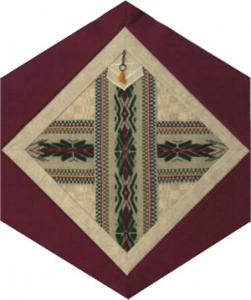Lithuania

The Block
A tone-on-tone background complements the patterned foreground of the Lithuanian block, designed and created by Danute Staskevicius and Kristina Bendzius Makauskas. The monochromatic background of this example of summer-winter weaving is typical of Lithuanian linens. Homespun woven juostas (sashes commonly worn around the waist or made narrower and worn as neckties) feature geometric shapes flanked by offset coloured blocks. The patterns and subtle colour combinations are but a sampling of the varied and complex designs used extensively in national folk costumes. Costumes are similar in appearance throughout the country, but the diversity of patterns, colours, articles of clothing and method of wearing them differ according to ethnographic regions. The amber drop embellishing the block is similar to those worn as neck ornaments. Almost 90 percent of the world’s amber (fossilized resin of ancient trees that lived 40 to 50 million years ago) comes from Lithuania, and this semi-precious deposit, known as ‘Lithuania’s gold,’ is widely used to make the jewelry that has become one of the country’s most prominent art forms.
Cultural Profile
Lithuania is a small country located on the eastern shore of the Baltic Sea. It is one of three countries that make up the Baltic States (the others are Latvia and Estonia). Lithuanian, the official language of the country, is one of only two surviving languages of the Baltic branch of the Indo-European language family. It is spoken by most people in the country, although Russian is still widely used. Lithuania has a wealth of cultural treasures: multi-coloured traditional costumes, melodious and lyrical folk songs (the country is often called ‘a land of singers’), and a vibrant oral tradition that includes folktales, legends, proverbs and dainos (ancient songs). Their rich heritage of folk music includes such traditional instruments as the daudytë (a long wooden trumpet), kanklës (one of the most ancient stringed instruments in the Baltic countries), skrabalai (small wooden bells) and skuduèiai (wooden panpipes). Lithuanian songs and dances are celebrated during folk song festivals, the largest of which takes place every four years. One of Lithuania’s most famous folk-art customs is reflected in the carved wooden crosses, suns, weathercocks or figures of saints on tall poles, which can be seen dotting crossroads, cemeteries, village squares and gardens throughout the country. The nation’s textile arts revolve mostly around weaving, especially that done with linen, and colourful embroidery. ‘Straw gardens’ are also a craft specific to Lithuania. These elaborate geometric structures are built out of straw, their shapes varying depending on the occasion for which they are built. Other arts and crafts include abstract painting, sculpture, ceramics, ironwork and basket weaving. Lithuanians are fiercely patriotic and take great pride in celebrating their culture through numerous annual festivals and fairs such as the massive St. Casimir Fair held in Vilnius every spring. Other festive occasions include Užgavėnės, or Shrove Tuesday, when people celebrate outdoors wearing masks and wigs, eating pancakes and asking winter to leave or Joninos, St. John’s Day, when bonfires are lit and friends and family gather to celebrate the through the entire night. All Souls Night, also a traditional custom followed by most Lithuanians, involves visiting the graves of loved ones, lighting candles for them and praying for each of them. The first recorded Lithuanians to immigrate to Canada were soldiers in the British army who fought in the War of 1812. However, it wasn’t until the end of the nineteenth century that significant numbers of Lithuanians began immigrating, many for political or economic reasons. By the early twentieth century Lithuanian communities had developed in Sydney Mines, Nova Scotia, Montréal and Toronto, as well as in the provinces of Alberta and Manitoba. Many people found work on farms, with the railways, in coal mines and factories. After World War II, nearly 20,000 refugees who called themselves Dievo Paukstai (God’s birds) arrived in Canada. They brought with them their skills as professionals, craftsmen and artists and many were successful in re-establishing themselves professionally. Lithuanians have integrated easily into Canadian society while maintaining a strong connection to their own culture. A variety of clubs, and singing and dancing groups have been established. They have Lithuanian schools, summer camps, newspapers (including Québec’s Independent Lithuania and Ontario’s Lights of Homeland), and cultural centres, such as the Anapilis (meaning ‘a city beyond’) Complex in Mississauga, Ontario. Lithuanians have made significant contributions to Canadian society in fields such as the arts, engineering, and education. The 2011 census reported a Lithuanian population of over 49,000; nearly two-thirds reside in Ontario.
Sponsor: Lithuanian Folk Art Group
